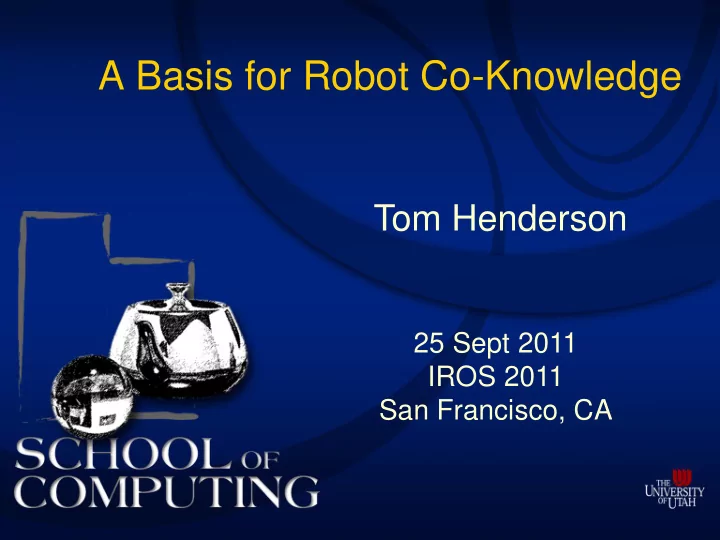

A Basis for Robot Co-Knowledge Tom Henderson 25 Sept 2011 IROS 2011 San Francisco, CA
Context for Robot Knowledge Sharing 2
National Robotics Initiative 3
National Robotics Initiative 4
Our Previous Work 5
RobotShare (2007) 6
RobotShare (2008) 7
Human Web vs Robot Web • Find info, including how-to-do (e.g., search engines based on words) Human • Run codes on local machine (e.g., Java: universal machine) • Find info (e.g., search engines based on ???) Robot • Run process on local robot (e.g., pick up glass requires reference models) 8
RobotShare (Find Info) 9
RobotShare (cont’d) Questions: 1. How does a robot communicate with RobotShare? 2. How does RobotShare process and answer a query? 3. How does one robot know if information stored on a website applies to its own environment? Goal: build a multi-format data search engine for robot knowledge sharing . 10
Other Approaches: RoboEarth “At its core, RoboEarth is a World Wide Web for robots: a giant network and database repository where robots can share information and learn from each other about their behavior and their environment. Bringing a new meaning to the phrase ``experience is the best teacher,’’ the goal of RoboEarth is to allow robotic systems to benefit from the experience of other robots, paving the way for rapid advances in machine cognition and behaviour, and ultimately, for more subtle and sophisticated human-machine interaction. 11
RoboEarth (cont’d) 12
RoboEarth • May lead to sharing at the knowledge level • Allows sharing of human knowledge • Requires basis for semantics of shared descriptions • Still relies on human guided (programmed) schemas (My interpretations!!) 13
So, there seems to be some effort to develop frameworks to share, … BUT … 14
Issue: How Knowledge is Acquired 1. Install Basic Learning Mechanisms Sensorimotor Data 15
How Knowledge is Acquired 1. Install Basic vs 2. Include Some Learning Mechanisms Innate Knowledge Sensorimotor Data 16
How Knowledge is Acquired 1. Install Basic 2. Include Some Learning Mechanisms Innate Knowledge Sensorimotor Data 3. Sensorimotor Reconstruction: Self-Knowledge 17
How Knowledge is Acquired 1. Install Basic 2. Include Some Learning Mechanisms Innate Knowledge 4. Cognitive Content Sensorimotor Symbolic vs Data Dynamical Systems 3. Sensorimotor Reconstruction: Self-Knowledge 18
How is Knowledge Shared? Basis for Sharing? 1. Install Basic 2. Include Some Learning Mechanisms Innate Knowledge 4. Creating Sensorimotor Cognitive Content Data 3. Sensorimotor Reconstruction: Self-Knowledge 19
Sharing What? • Physical Symbol Systems: cognition as a computer Share machines/formulas? • Artificial Neural Networks: cognition as a neural network Share topology/weights? • Dynamical Systems: cognition as differential equations share equations? 20
Thoughts • Difficult to see a general way to share across these paradigms • Difficult to see how sharing occurs within some paradigms • Constraints from these issues should inform approaches to knowledge sharing as well as proscribe some 21
How does U Mass’ Arny convey “ how to throw a ball ” to Willow Garage’s PR2? Knowledge Sharing? 22
Our current ideas … (see Poster in Workshop!) 1. Some innate structures shared by all robots • Symmetry detectors and operators • Operate from sensor/actuator level on up • Exploit SE(3), SO(3), etc. • Use embodiment coordinates (not XYZ frame) 23
Our current ideas (cont’d) 2. Consider role of symmetry in structural bootstrapping (e.g., in EU Xperience project) • Sensorimotor (SM) level (as in previous slide) • More abstract level (derived from SM level) • Linguistic level (vocabulary of symbols derived from abstract level) Share at second two levels 24
Structural Bootstrapping (Xperience Project) “The Xperience project addresses this problem by structural bootstrapping, an idea taken from language acquisition research: knowledge about grammar allows a child to infer the meaning of an unknown word from its grammatical role together with understood remainder of the sentence. Structural bootstrapping generalizes this idea for general cognitive learning: if you know the structure of a process the role of unknown actions and entities can be inferred from their location and used in the process. This approach will enable rapid generalization and allows agents to communicate effectively .” 25
Structural Bootstrapping (Xperience Project) 26
Symmetry Based Structural Bootstrapping 1D, 2D, 3D Symmetries Symmetry Detectors Sensorimotor Data 27
Symmetry Based Structural Bootstrapping Group Products Prime Factorization 1D, 2D, 3D Symmetries Symmetry Detectors Sensorimotor Data 28
Symmetry Based Structural Bootstrapping Can be stored, Can be shared compared, and applied Group Products Prime Factorization 1D, 2D, 3D Symmetries Symmetry Detectors Sensorimotor Data 29
Symmetry Based Structural Bootstrapping Can be stored, Can be shared compared, and applied Group Products (see Leyton, Rhodes, …) Prime Factorization An innate representation 1D, 2D, 3D Symmetries Symmetry Detectors Sensorimotor Data 30
Group-Theoretic Bootstrapping (IROS 2011) 31
Questions? 32
Recommend
More recommend